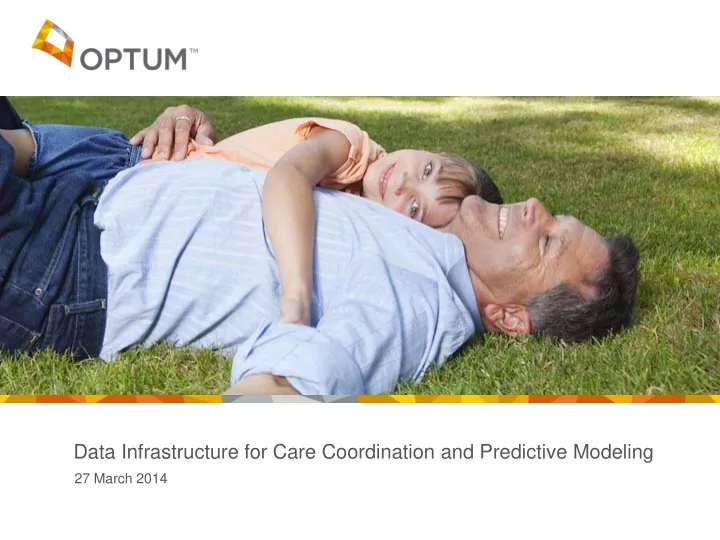

Data Infrastructure for Care Coordination and Predictive Modeling 27 March 2014
Key Points • Effective use of data is a key to achieving greater value for the health care dollar in Maryland. • Establishing an appropriate information infrastructure will require collaboration and a shared vision of how information will be used. • It will also take time – Establish priorities – Understand your roadmap – Sustain your investment • Care coordination and predictive modeling require different information delivered at different points in time • Active clinical engagement will be critical Confidential property of Optum. Do not distribute or reproduce without express permission from Optum. 2
Using Data Effectively to Enhance Value Get the information where it needs to be for collaboration… Data Analytics and Decision Support Care and Population Management eOrdering, Image Exchange, etc. Inter-HIE Collaboration Enable collaboration between all participant entities and providers, Push regardless of discrete end-user clinical tools. Access …and what does the data tell us data to to Community physicians wide view of so we can REALLY improve care into their patient tool of choice and reduce costs, near- and long- term. Confidential property of Optum. Do not distribute or reproduce without express permission from Optum.
Shared Data Assets As The Foundation Infrastructure Members/ Health Plan Self report Patients Claims Point of Care/ EMR ( Direct, Clearing House, 3013 HIE) Providers Clinical Analytics Platform Administrative/Clinical Real-Time HIE (e.g. HL7, EDI) Cohorts Analytics • Research •Quality •Episodes • Selection • Management •Cost of Care •Disease •Risk User Provider •Care team Configuration Engagement •Lab trends • Analytics “Interface” • Audiences Campaigns - Integration, Security • Cohorts •Design - EHR • Campaigns •Monitor - Analytics/Gaps • Systems •Messages Patient View – Messages, disease/conditions, Gaps Population View – Registries, Interventions Enterprise Data Mart Member/Patient Performance View – Quality, Cost/Utilization (R&R) Normalized EMR Data, Engagement “Interface” Claims and Analytic Results - Integration, Security - PHR - Analytics/Gaps - Directories Confidential property of Optum. Do not distribute or reproduce without express permission from Optum.
Population Segmentation Mutually exclusive segmented approach to the Population using a Health Continuum Model and member clinical and risk attributes Confidential property of Optum. Do not distribute or reproduce without express permission from Optum. 5
Patient Attributes Used in Predictive Models Conditions and comorbidities – both physical and behavioral Relative risk for future cost and use Gaps in care relative to evidence-based medicine Prior use of acute care, including inpatient and ER Strength of Member-Provider Relationship Provider cost and quality performance Confidential property of Optum. Do not distribute or reproduce without express permission from Optum. 6
Data Considerations • Complete medical claims and enrollment is a must because they provide diagnoses, utilization, costs and other basic information • Pharmacy claims – Supports assessments of prior use – Adds incremental value to predictive modeling – Essential for identifying gaps in care – a good deal of opportunity on making sure patients are on proper meds, looking for drug interactions, appropriate monitoring for patients on meds (visits and lab tests, etc.) • Lab results – Useful to measure outcomes (e.g., HbA1c levels for diabetics) – Adds value to predictive modeling • HRA results can be helpful – especially for new patients – e.g., patients coming in from the exchanges • Timeliness of data – important for some population segments – pharmacy data is more timely. Authorization data is a plus • Predictive modeling is an important element of a segmentation strategy – Predictions of costs or future utilization – Likelihood of future chronic or catastrophic conditions Confidential property of Optum. Do not distribute or reproduce without express permission from Optum. 7
Health Continuum Categories Category Criteria 1: Healthy Low risk, without Chronic dx, gaps, ER/IP (last 12 mos). Without Chronic dx, with 1+ ER/IP – e.g. NICU, High Risk 2: Healthy: Acute (IP or ER) Pregnancy, Fertility Treatment 3: No Chronics: Close Gaps/Reduce Risk Without Chronic dx (all others), Some gaps or moderate risk Diabetes, CHF, CAD, COPD/Asthma , moderate risk, limited 4a: Chronic 5 : Stable gaps, without ER/IP BH, without other chronic conditions, moderate risk, limited 4b: Behavioral Health Only: Stable gaps, without ER/IP Chronic dx (excluding Chronic 5 ), moderate risk, limited gaps, 4c: Chronic Other: Stable without ER/IP Diabetes, CHF, CAD, COPD, Asthma, with higher risk or gaps 5a: Chronic 5 : Interventional or ER/IP 5b: BH Only: Interventional BH dx only, with gaps or ER/IP or higher risk 5c: Chronic Other: Interventional Chronic dx (excl Chronic 5 ), with gaps, ER/IP, or higher risk Confidential property of Optum. Do not distribute or reproduce without express permission from Optum. 8
Health Continuum Categories Category Criteria Significant risk: Cost risk >15 (seniors), >10 (adult/peds) OR 6: Chronic High Risk IP probability risk >50% or PRG risk >10 CF, MS, ALS, Gaucher's, Parkinson’s, Myasthenia Gravis, RA, 7: Rare High Cost Condition Lupus, Sickle Cell, Hemophilia, Dermatomyositis, Polymyositis, Scleroderma 8a: Catastrophic: Active Cancer Cancer with active treatment (chemo, radiation, etc) 8b: Catastrophic: Transplant Solid organ and soft tissue 8c: Catastrophic: Dialysis Hemo- or peritoneal dialysis 9: Dementia Dementia 10: Terminal (EOL) Hospice or metastatic cancer Confidential property of Optum. Do not distribute or reproduce without express permission from Optum. 9
Member Segmentation Detail ( Chronic 5 excluded) Confidential property of Optum. Do not distribute or reproduce without express permission from Optum. 10
Impactable Members Categories: Examples (mutually exclusive, reflects client input) • Pre-dialysis • Drug safety • High ER Use (5+ ER visits) • Moderate ER and Limited/No Provider Relationship • High Medication Adherence Issues (3+ gaps) • Moderate Med Adherence Issues and Limited/No Provider Relationship • Multiple Chronic Conditions, including BH • Movers: Future Cost $35,000 higher than Prior Cost • New Transplants in last 12 mos • Terminal (EOL) – Metastatic Cancer and advanced age Confidential property of Optum. Do not distribute or reproduce without express permission from Optum. 11
Thank You Dean Farley, PhD, MPA Vice President, Optum Dean.Farley@optum.com 860-221-0665
Recommend
More recommend